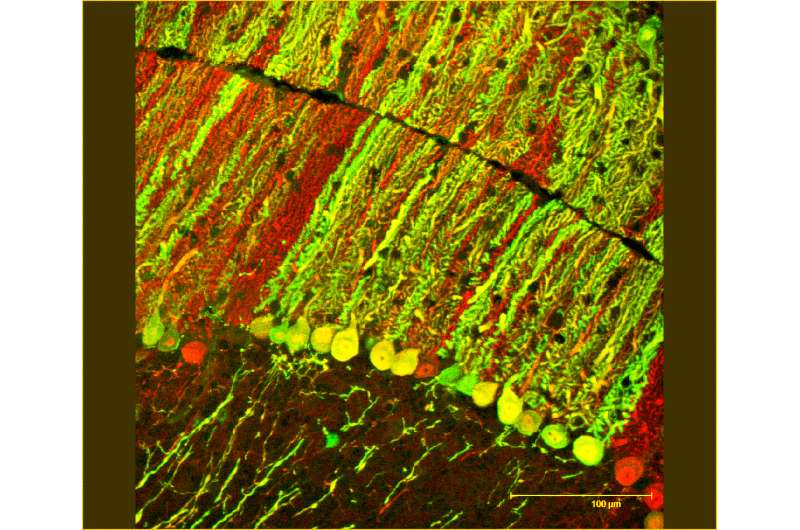New technique targets gene that causes neurodegenerative disease

Neuroscientists at the University of Chicago studying a unique gene that expresses two proteins, one that is necessary for life and another, that when mutated causes a neurodegenerative disease called spinocerbellar ataxia type 6 (SCA6), have developed a technique to selectively block the disease-causing protein without affecting the other.
In a new study, published July 13, 2016, in Science Translational Medicine, the researchers show how they were able to use a modified virus to deliver a small sequence of RNA called micro RNA (miRNA) that blocked the expression of the mutated protein and prevented SCA6 from developing in mice. The technique could potentially be used to treat other diseases caused by mutations in so-called "bicistronic" genes that produce multiple proteins, including several forms of cancer.
"We were able to very surgically strike at the toxic portion of the gene and blunt the sharp end of the spear," said Christopher Gomez, MD, PhD, the Albina Y. Surbis Professor of Neurology at the University of Chicago and senior author of the study. "It's a technique for shutting down disease-causing genes that could have fewer off target effects."
SCA6 is an inherited neurodegenerative disease that strikes in middle age and causes patients to slowly lose coordination of their muscles and eventually their ability to speak and stand. Human genetic studies identified its cause as a mutation in CACNA1A—a gene that encodes a calcium channel protein important for nerve cell function. In 2013, Gomez and his team discovered that CACNA1A also produces a second protein, α1ACT, making it the first known human gene that codes two separate, functionally distinct proteins from one strand of messenger RNA.
Normally, α1ACT enhances the growth of brain cells, but when mutated it causes brain cell death leading to SCA6. In animal models of the disease, if researchers knock out the entire CACNA1A gene, the animals do not survive more than a few weeks because they need the calcium channel protein for proper development.
Yu Miyazaki, MD, PhD, a postdoctoral scholar in the UChicago Department of Neurology, led the new study. The research team was able to use a modified adeno-associated virus, a small virus not currently known to cause disease, to deliver a miRNA sequence in mice with the disease-causing mutation in CACNA1A. This prevented the development of SCA6 by blocking the expression of α1ACT.
Because SCA6 is an inherited disease, the findings could be used one day for screening and prevention. People with a known family history of the disease could be screened for the CACNA1A mutation and treated with a similar miRNA application. Gomez and his team are also researching other delivery mechanisms using molecules and known drugs instead of viruses.
The miRNA technique may also be used to treat other diseases caused by mutations in bicistronic genes. While only a handful of others have been discovered since CACNA1A, they include genes linked to melanoma and hereditary breast cancer.
"This sets us up to be able to use the same strategy with other molecules that could suppress other genes," Gomez said. "It opens many more doors that could answer how we can use it for human treatments."
More information: "An miRNA-mediated therapy for SCA6 blocks IRES-driven translation of the CACNA1A second cistron," Science Translational Medicine, stm.sciencemag.org/lookup/doi/ … scitranslmed.aaf5660


















